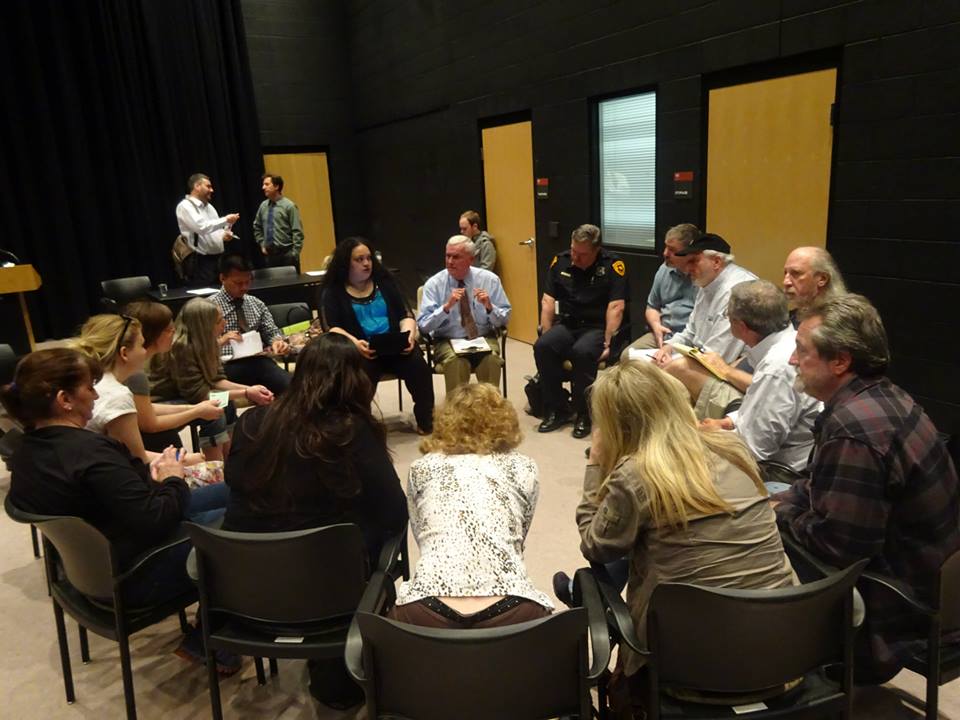By Haley Sotelo
Capital West News
SALT LAKE CITY — With the subject of police brutality becoming a national issue, Salt Lake City community leaders and citizens gathered at a “Know Your Rights” meeting to combat the issue on a local basis.
The Mar. 18 event was the third and final meeting of a series held at the Sorenson Unity Center on the subject of police use of force. Salt Lake City Mayor Ralph Becker and several other speakers gave brief presentations on what to do if one is detained such as plead the Fifth Amendment, ask for a lawyer, do what you are told, and get the names of the officers involved.

Attendees, who were already sitting in five circles, were then asked to form group dialogs on officer-involved shootings, how to respond to law enforcement, and other concerns that they had. Each group had community leaders and police officers involved in the discussion, including Rep. Angela Romero-D, Salt Lake City, and Salt Lake City Police Chief Chris Burbank.
Mediators began the conversations by presenting a list of rules necessary for having open communication when discussing sensitive and confrontational issues. Participants were asked to use “I” statements rather than “you” or “they” statements, to seek for understanding, and to respect the confidentiality of sensitive experiences. Finally, attendees were instructed that the dialog should be an opportunity for voices to be heard and not be argumentative.
The groups were diverse and included members of the African-American, Polynesian, Hispanic, and immigrant communities. One biracial man spoke of being apprehended and accused of a crime because of his color. He had dreadlocks at the time, and that fact alone had saved him as the victim recalled that her offender did not have long hair.
In response to a white woman’s suggestion that police response depends on conduct at the time of confrontation, the man replied “I will get handled more than you” because he is “brown.”
Fahina Tavake-Pasi, the Executive Director of the National Tongan American Society, said that Polynesians are treated differently, particularly when their teenagers are pulled over because police assume that they are getting into trouble. She even referred to a study showing that police officers assume people of color are two years older than their actual age and white people are two years younger.
“I think a lot of our kids feel threatened when the police approach them,” Tavake-Pasi said. “It’s just really sad the way that our community is threatened by police officers when they should be feeling safe.”
The physical makeup of Polynesians, according to Tavake-Pasi, is different when compared to those of other races. This can be seen in the bone structure and the way that weight is proportioned. Subsequently, they appear older and can frighten police officers who are not as big as they are.
Laura Love, a 21 year-old community activist from Mexico City and resident of Salt Lake City, was a participant in one of the groups that talked about racial profiling. They also talked about educating both the public and the officers.
“I was shocked,” Love said in response to the meeting. “I was amazed at how much power and how many voices are ready to stand up and act on what we’re talking about.”
Romero emphasized the need to listen to the voices of others and learn from their experiences. If we don’t listen, then the changes we seek can’t happen, she said.
Although most of the groups spoke English, one group was speaking Spanish. Deputy Chief Isaac Atencio was the officer speaking with them. The group expressed their fear of police that is tied to their experiences in other countries.
Many ethnic groups were not represented at the meeting, but there are ongoing opportunities for these types of interactions, Atencio said. Various centers and churches across Salt Lake City meet this need for the international community by providing awareness classes, he added.
Attendees seemed to appreciate the event. One citizen mentioned that the experience gave her compassion for police officers.
“I am one that will always say ‘dialog is where it needs to be and that is what’s important,” Chief Burbank said. “We need to hear people who are upset. We need to hear people who are happy [or] dissatisfied. I mean, whatever the circumstances are and that input is what is important.”
Although this was the final meeting for this series, many seemed interested in finding a way to have similar meetings in the future.




